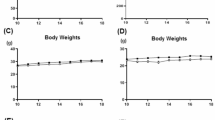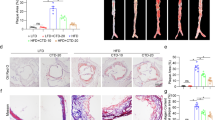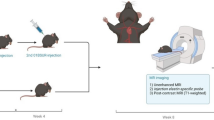Abstract
Angiotensin II type 1 receptor may contribute to atherogenesis by facilitating the proliferative and inflammatory response to hypercholesterolemia. In the present study, we investigated the long-term effect of angiotensin II type 1a receptor (AT1a) deficiency on hypercholesterolemia-induced atherosclerosis by the use of AT1a-knockout (AT1a-KO) mice and apolipoprotein E-knockout (apoE-KO) mice. AT1a-KO were crossed with apoE-KO, generating double-knockout (D-KO) mice. Mice were fed a standard diet and analyzed at 25- or 60-weeks-old. The quantification of atherosclerotic volume in the aortic root revealed that the atherosclerotic lesions of D-KO mice were significantly smaller than those of apoE-KO mice at 25-week-old (0.81±0.16 mm2 vs. 1.05±0.21 mm2, p<0.001) and at 60-week-old (0.89±0.11 mm2 vs. 2.44±0.28 mm2, p<0.001). Surprisingly, there was no significant difference in atherosclerotic lesion size of D-KO mice at 25- and 60-week-old, suggesting that AT1a deficiency completely protected against the age-related progression of atherosclerosis. The amounts of collagen and elastin, the expression of p22phox, serum amyloid P (SAP), matrix metalloproteinase (MMP)-2, and MMP-9, and the number of apoptotic cells of D-KO mice were lower than those of apoE-KO mice. Furthermore, we confirmed that the expression of procollagen α 1(I), procollagen α 1(III), tropoelastin, p22phox, SAP, MMP-2, and MMP-9 decreased in cultured vascular smooth muscle cells from D-KO mice compared with those of apoE-KO mice. In conclusion, AT1a deficiency reduces atherosclerotic lesion size of apoE-KO mice and protects against the age-related progression of atherosclerosis. Reduction of oxidative stress, apoptosis, and MMP expression in atherosclerotic lesions by AT1a deficiency may contribute to plaque size.
Similar content being viewed by others
Article PDF
References
Libby P, Ridker PM, Maseri A : Inflammation and atherosclerosis. Circulation 2002; 105: 1135–1143.
Nicenig G, Harrison DG : The ATM1-type angiotensin receptor in oxidative stress and atherogenesis. Part I: Oxidative stress and atherogenesis. Circulation 2002; 105: 393–396.
Miura S, Saku K, Karnik SS : Molecular analysis of the structure and function of the angiotensin II type 1 receptor. Hypertens Res 2003; 26: 937–943.
Griendling KK, Ushio-Fukai M, Lassegue B, Alexander RW : Angiotensin II signaling in vascular smooth muscle. New concepts. Hypertension 1997; 29: 366–373.
Kranzhofer R, Schmidt J, Pfeiffer CA, Hagl S, Libby P, Kubler W : Angiotensin induces inflammatory activation of human vascular smooth muscle cells. Arterioscler Thromb Vasc Biol 1999; 19: 1623–1629.
Hernandez-Presa M, Bustos C, Ortego M, et al: Angiotensin-converting enzyme inhibition prevents arterial nuclear factor kappa B activation, monocyte chemoattractant protein-1 expression, and macrophage infiltration in a rabbit model of early accelerated atherosclerosis. Circulation 1997; 95: 1532–1541.
Tummala PE, Chen XL, Sundell CL, et al: Angiotensin II induces vascular cell adhesion molecule-1 expression in rat vasculature: a potential link between the renin-angiotensin system and atherosclerosis. Circulation 1999; 100: 1223–1229.
Ferrario CM : Use of angiotensin II receptor blockers in animal models of atherosclerosis. Am J Hypertens 2002; 15: 9S–13S.
Takai S, Jin D, Sakaguchi M, et al: Comparative effects of candesartan and amlodipine in a monkey atherosclerotic model. Hypertens Res 2004; 27: 517–522.
Wassmann S, Czech T, van Eickels M, Fleming I, Bohm M, Nickenig G : Inhibition of diet-induced atherosclerosis and endothelial dysfunction in apolipoprotein E/angiotensin II type 1A receptor double-knockout mice. Circulation 2004; 110: 3062–3067.
Daugherty A, Rateri DL, Lu H, Inagami T, Cassis LA : Hypercholesterolemia stimulates angiotensin peptide synthesis and contributes to atherosclerosis through the AT1A receptor. Circulation 2004; 110: 3849–3857.
Nyby MD, Abedi K, Smutko V, Eslami P, Tuck ML : Vascular angiotensin type 1 receptor expression is associated with vascular dysfunction, oxidative stress and inflammation in fructose-fed rats. Hypertens Res 2007; 30: 451–457.
Smith JD, Trogan E, Ginsberg M, Grigaux C, Tian J, Miyata M : Decreased atherosclerosis in mice deficient in both macrophage colony-stimulating factor (op) and apolipoprotein E. Proc Natl Acad Sci U S A 1995; 92: 8264–8268.
Tangirala RK, Rubin EM, Palinski W : Quantification of atherosclerosis in murine model: correlation between lesions in the aortic origin and in the entire aorta, and differences in the extent of lesions between sexes in LDL receptor–deficient and apolipoprotein E–deficient mice. J Lipid Res 1995; 36: 2320–2328.
Miyata M, Biro S, Kaieda H, et al: Apolipoprotein J/clusterin is induced in vascular smooth muscle cells after vascular injury. Circulation 2001; 104: 1407–1412.
Obata H, Biro S, Arima N, et al: NF-kappa B is induced in the nuclei of cultured rat aortic smooth muscle cells by stimulation of various growth factors. Biochem Biophys Res Commun 1996; 224: 27–32.
Eto H, Biro S, Miyata M, et al: Angiotensin II type 1 receptor participates in extracellular matrix production in the late stage of remodeling after vascular injury. Cardiovasc Res 2003; 59: 200–211.
Bohm M, Raghunath M, Sunderkotter C, et al: Collagen metabolism is a novel target of the neuropeptide alpha-melanocyte–stimulating hormone. J Biol Chem 2004; 279: 6959–6966.
Bunda S, Kaviani N, Hinek A : Fluctuations of intracellular iron modulate elastin production. J Biol Chem 2005; 280: 2341–2351.
Rupin A, Paysant J, Sansilvestri-Morel P, et al: Role of NADPH oxidase–mediated superoxide production in the regulation of E-selectin expression by endothelial cells subjected to anoxia/reoxygenation. Cardiovasc Res 2004; 63: 323–330.
Wei W, Parvin N, Tsumura K, et al: Induction of C-reactive protein, serum amyloid P component, and kininogens in the submandibular and lacrimal glands of rats with experimentally induced inflammation. Life Sci 2001; 69: 359–368.
Kodali R, Hajjou M, Berman AB, et al: Chemokines induce matrix metalloproteinase-2 through activation of epidermal growth factor receptor in arterial smooth muscle cells. Cardiovasc Res 2006; 69: 706–715.
Abe N, Osanai T, Fujiwara T, Kameda K, Matsunaga T, Okumura K : C-reactive protein–induced upregulation of extracellular matrix metalloproteinase inducer in macrophages: inhibitory effect of fluvastatin. Life Sci 2006; 78: 1021–1028.
Eto H, Miyata M, Kume N, et al: Expression of lectin-like oxidized LDL receptor-1 in smooth muscle cells after vascular injury. Biochem Biophys Res Commun 2006; 341: 591–598.
Suzuki J, Otsuka F, Inagaki K, et al: Primary aldosteronism caused by a unilateral adrenal adenoma accompanied by autonomous cortisol secretion. Hypertens Res 2007; 30: 367–373.
Seshiah PN, Weber DS, Rocic P, Valppu L, Taniyama Y, Griendling KK : Angiotensin II stimulation of NAD(P)H oxidase activity: upstream mediators. Circ Res 2002; 91: 406–413.
Harrison D, Griendling KK, Landmesser U, Hornig B, Drexler H : Role of oxidative stress in atherosclerosis. Am J Cardiol 2003; 91: 7A–11A.
Nakano D, Hayashi T, Tazawa N, et al: Chronic hypoxia accelerates the progression of atherosclerosis in apolipoprotein E–knockout mice. Hypertens Res 2005; 28: 837–845.
Zalba G, San José G, Moreno MU, et al: Oxidative stress in arterial hypertension: role of NAD(P)H oxidase. Hypertension 2001; 38: 1395–1399.
Clempus RE, Griendling KK : Reactive oxygen species signaling in vascular smooth muscle cells. Cardiovasc Res 2006; 71: 216–225.
Hitomi H, Fukui T, Moriwaki K, et al: Synergistic effect of mechanical stretch and angiotensin II on superoxide production via NADPH oxidase in vascular smooth muscle cells. J Hypertens 2006; 24: 1089–1095.
Kusaka I, Kusaka G, Zhou C, et al: Role of AT1 receptors and NAD(P)H oxidase in diabetes-aggravated ischemic brain injury. Am J Physiol Heart Circ Physiol 2004; 286: H2442–H2451.
Naya M, Tsukamoto T, Morita K, et al: Olmesartan, but not amlodipine, improves endothelium-dependent coronary dilation in hypertensive patients. J Am Coll Cardiol 2007; 50: 1144–1149.
Chabrashvili T, Kitiyakara C, Blau J, et al: Effects of ANG II type 1 and 2 receptors on oxidative stress, renal NADPH oxidase, and SOD expression. Am J Physiol Regul Integr Comp Physiol 2003; 285: R117–R124.
Rabbani R, Topol EJ : Strategies to achieve coronary arterial plaque stabilization. Cardiovasc Res 1999; 41: 402–417.
Keidar S, Attias J, Smith J, Breslow JL, Hayek T : The angiotensin-II receptor antagonist, losartan, inhibits LDL lipid peroxidation and atherosclerosis in apolipoprotein E–deficient mice. Biochem Biophys Res Commun 1997; 236: 622–625.
Author information
Authors and Affiliations
Corresponding author
Rights and permissions
About this article
Cite this article
Eto, H., Miyata, M., Shirasawa, T. et al. The Long-Term Effect of Angiotensin II Type 1a Receptor Deficiency on Hypercholesterolemia-Induced Atherosclerosis. Hypertens Res 31, 1631–1642 (2008). https://doi.org/10.1291/hypres.31.1631
Received:
Accepted:
Issue date:
DOI: https://doi.org/10.1291/hypres.31.1631
Keywords
This article is cited by
-
MaxiK channel and cell signalling
Pflügers Archiv - European Journal of Physiology (2014)
-
Genetic Variants of the Renin Angiotensin System: Effects on Atherosclerosis in Experimental Models and Humans
Current Atherosclerosis Reports (2010)



